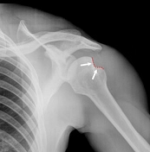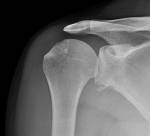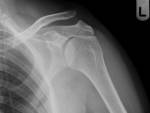Shoulder injuries
- when painful shoulder conditions present seemingly as trauma without obvious Hx of trauma think of other conditions:
Shoulder dislocation
- anterior >95%
- subcoracoid (majority)
- subglenoid (1/3)
- subclavicular (rare)
- posterior 2-4%
- inferior (luxatio erecta) <1%
- post dislocations may be missed on AP film - transcapular view is therefore important if suspicious
- axillary N is the most commonly injured N - examine for signs of other brachial plexus injury also
- axillary art damage may also occur esp in the elderly
Techniques for reduction
various techniques for reduction, but each should be slowly and gently. Too fast and M spasm will counter efforts!!
- Stimson
- patient lies prone with weight attached to hand of affected arm which is hanging over the side of the bed
- scapular manipulation method
- patient lies prone as with Stimson but scapula is then rotated clockwise
- external rotation method
- patient is supine or sitting. The flexed arm is adducted and then externally rotated
- Milch technique
- fully abduct the arm and apply longitudinal traction followed by external rotation
- FARES method
- supine or relaxed sitting position, applying longitudinal traction then slowly abduct and oscillate arm up and down
- Spaso technique
- with patient supine, affected arm held around the wrist or distal forearm & lifted vertically, applying upward traction & gentle external rotation
- Davos technique
- patient sits with ipsilateral hip & knee in full flexion. Fingers are then clasped (locked) beneath the knee and the patient is encouraged to relax and lean backward
Acromio-clavicular joint injury
| Rockwood classification of injury | |
|---|---|
| Type I | • clavicle not elevated with respect to the acromion • all lig's intact |
| Type II | • clavicle elevated but not above the superior border of the acromion • AC lig and capsule ruptured |
| Type III | • clavicle elevated above superior border of acromion but coraco-clavicular distance <2x normal (ie <25mm) • all lig's and capsule ruptured • deltoid and trapezius M's detached |
| Type IV | • clavicle displaced posterior into trapezius • all lig's and capsule ruptured • deltoid and trapezius M's detached |
| Type V | • clavicle is markedly elevated and coraco-clavicular distance >2x normal (ie >25mm) |
| Type VI | • rare - clavicle inferiorly displaced behind coraco-brachialis & biceps tendons |
| Types IV, V, VI are effectively variants of Type III | |
Management
Non-operative
- brief sling immobilization, rest, ice, physio
- type I, II & type III in most especially if clavicle displaced <2cm
- with rehab early shoulder range of motion
- functional motion usually within 6/52
- normal activity usually within 12/52
Operative
- for high grade injuries but some doubt over superiority of results
- may be more for cosmetic reasons
Proximal Humeral fractures
- 2 types of classification:
- Neer Classification. Based on (a)parts fractured rather than the fracture line and (b) extent of displacement
- 1 Part fracture: 80% of proximal humeral fractures. Fracture lines involve 1-4 parts. None of the parts are displaced (i.e <1 cm and <45 degrees)
- 2 Part fracture: fracture lines involve 2-4 parts with 1 part displaced (i.e >1 cm or >45 degrees)
- 4 subtypes of two-part fractures (one for each part):
- surgical neck: most common
- greater tuberosity - frequently seen in the setting of anterior shoulder dislocation. A lower threshold of displacement (>5 mm) has been proposed
- anatomical neck
- lesser tuberosity: uncommon
- 3 Part fracture: fracture lines involve 3-4 parts, with 2 parts displaced (i.e >1 cm or >45 degrees)
- 2 subtypes:
- greater tuberosity and shaft are displaced with respect to the lesser tuberosity and articular surface which remain together
- lesser tuberosity and shaft are displaced with respect to the greater tuberosity and articular surface which remain together
- 4 Part fracture: uncommon. Fracture lines involve more than 4 parts with 3 parts displaced (i.e., >1 cm or >45 degrees) with respect to the 4th
- AO classification, each with subtypes, with the risk of avascular necrosis of the articular surface increasing from A to C:
- type A: extra-articular unifocal (either tuberosity +/- surgical neck of the humerus)
- type B: extra-articular bifocal (both tuberosities +/- surgical neck of the humerus or glenohumeral dislocation)
- type C: extra-articular (anatomical neck) but with compromise to the vascular supply of the articular segment
Management:
- the vast majority of proximal humeral fractures are managed conservatively with supportive sling with physiotherapy to support early (7-10/7) mobilisation
- intervention usually for displaced articular and peri-articular fractures
- most common definition of displacement is ≥1cm between fracture fragments or ≥45° of angulation between fragments



